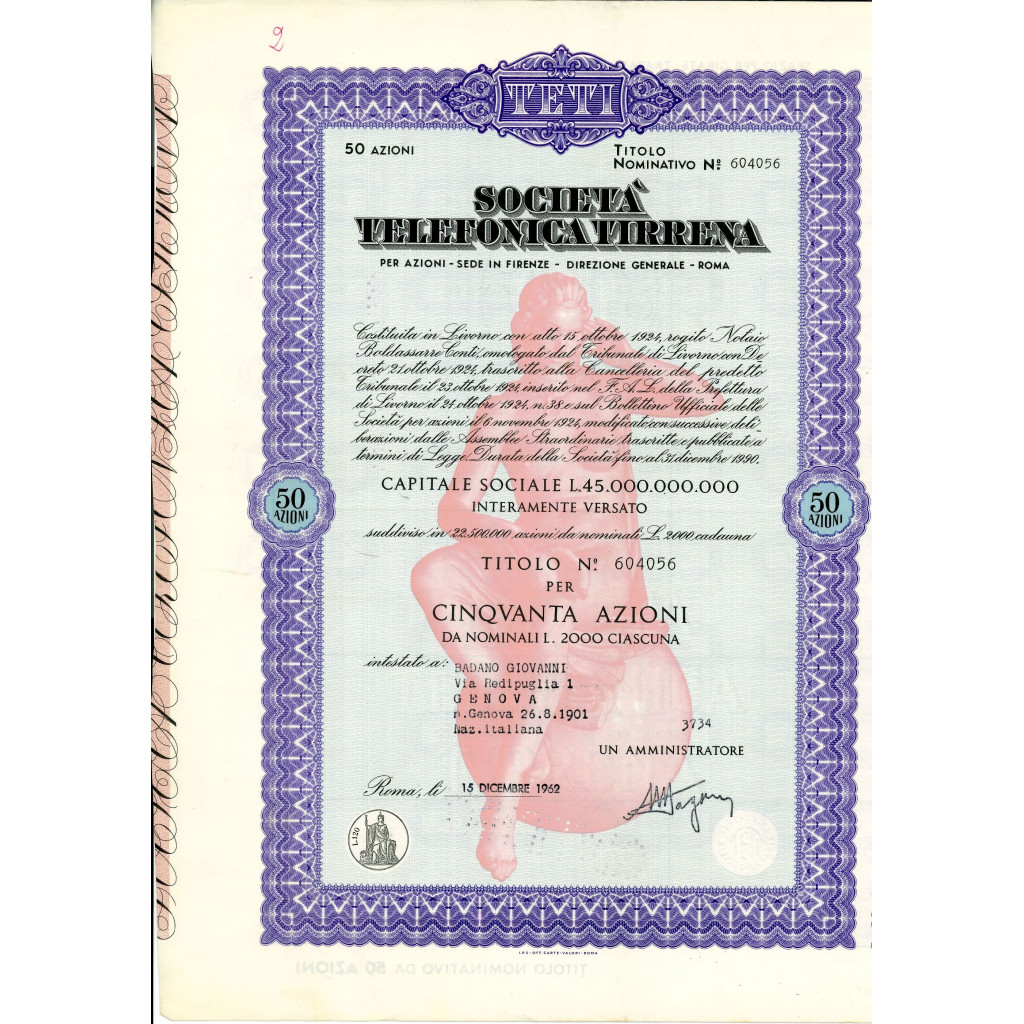TETI (Società Telefonica Tirrena) was an Italian telephone company operating in Liguria, Tuscany, Latium, Sardinia and the Orvieto district of Umbria; in 1964 it would be merged and incorporated into SIP.
The legislative system regarding telephone concessions, which dated back to 1881, when the first companies were formed to manage the telephone service in Italian cities, needed a reorganization of the management itself: whether to prefer state management or management under concession to private individuals. By Royal Decree No. 399 of February 8, 1923, the second solution was preferred, partly so as not to burden the state with the huge outlays for the necessary investments for the development of the service, which was growing enormously throughout the industrialized world. A special commission prepared the specifications to be stipulated with the new concessionaires, fixing the division of the service into five territorial zones, plus a sixth for long-distance telephone operation.
TE.TI. (Telefonica Tirrena) was founded in Livorno by Luigi Orlando and Alberto Pirelli on October 15, 1924. It was managed by the finance company "La Centrale" to obtain the telephone service concession. In 1925 TE.TI. won the tender, being awarded the fourth zone, which included the regions of Liguria, Tuscany, Latium, Sardinia and, as an anomaly with respect to the national telephone regulatory plan, the Orvieto district, which, being in Umbria, should have been under TIMO, concessionaire for the third zone.
After the first three years of management, the results were remarkable: subscribers grew from 37,105 on July 1, 1925 to 58,380 on September 30, 1928; urban centers increased from 45 to 85; offices and public posts from 916 to 1020; intercity lines from 7,528 km to 10,554 km; and the number of installed sets rose to 73,000. In addition, considerable work was carried out in Rome to the tune of over one hundred million liras, and by September 30, 1928 seven automatic stations were operating: the two largest (Corso Vittorio and Santa Maria in Via) catered to the traffic of the center, while Prati, Salaria, Appia, Parioli and Nomentana served the needs of the suburbs; the total capacity of the Roman stations exceeded 60,000 numbers.
The automatic system was also extended to Genoa, Florence, Livorno and almost all smaller towns. Livorno was the company's first headquarters, as the shareholders included some members of the family of Costanzo Ciano, then minister of Posts and Telecommunications.
After the arrangement of the large urban networks, extensive work began on the reorganization and expansion of the intercity network under its jurisdiction; at the same time, the reorganization and improvement of the rural automatic service was also taken care of.
Following the crisis of the 1930s and the outbreak of World War II, many of Italy's telephone networks were damaged and in some cases destroyed. This situation led to a sharp decline in subscribers throughout Italy; particularly in the areas controlled by TE.TI. there was a significant reduction in subscribers, which from 208,455 in 1942 became 163,388 in 1944.
In the immediate postwar period the telephone concessionaires worked to restore the devastation wrought by the war; this was essential for the growth of urban and long-distance networks and, above all, for a strong recovery in subscriber numbers. By the end of 1962 the main goal of one million new subscribers was achieved by TE.TI.
In 1945 TE.TI. made the first three-slot telephone token that could be used in any type of public telephone.
In 1958 IRI acquired the majority shareholdings of TE.TI. transferring them to STET, which was IRI's sector finance company established in 1933. Thus began the process of unifying the telephone system, which ended in 1964 with the merger by incorporation of TE.TI. and the other four concessionary companies into SIP - Società idroelettrica piemontese, which later changed its name to Sip (Società italiana per l'esercizio telefonico). It invested in the telephone sector the revenues obtained from the nationalization of the electric service it operated in northern Italy. Translated with www.DeepL.com/Translator (free version)




